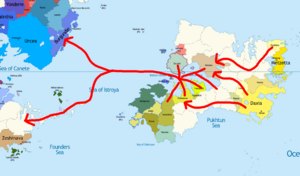Pre-modern global trade: Difference between revisions
mNo edit summary Tag: 2017 source edit |
Tag: 2017 source edit |
||
| Line 30: | Line 30: | ||
==Pre-modern slave trade== | ==Pre-modern slave trade== | ||
===Oduniyyad Caliphate chattel slavery network=== | |||
{{Further|Oduniyyad Caliphate}} | |||
===Bergendii chattel slavery network=== | |||
{{Further|Burgoignesc colonial empire}} | |||
==Other trans-oceanic trade routes== | ==Other trans-oceanic trade routes== | ||
===Bourgondi/Martillien-Canespa trade=== | ===Bourgondi/Martillien-Canespa trade=== | ||
Revision as of 21:19, 4 April 2024
| This article is a stub. You can help IxWiki by expanding it. |
| Business logistics |
|---|
| Distribution methods |
| Management systems |
| Industry classification |
| Historical business logistics |
|
Sea of Istroya trade network
The main participants in Sea of Istroya commerce were the class of Ancient Istroyan traders known as emporoi (ἕμποροι). The Ancient Istroyan states collected a duty on their cargo, typically at 1% or higher. By the end of the 5th century, the tax had been raised to 33 talents in more high-use ports. The growth of trade in Ancient Istroya led to the development of financial techniques. Most merchants, lacking sufficient cash assets, resorted to borrowing to finance all or part of their expeditions. A typical loan for a large venture in 4th century BC, was generally a large sum of cash (usually less than 2,000 drachmas), lent for a short time (the length of the voyage, a matter of several weeks or months), at a high rate of interest (often 12% but reaching levels as high as 100%). The terms of the contract were always laid out in writing, differing from loans between friends (eranoi). The lender bore all the risks of the journey, in exchange for which the borrower committed his cargo and his entire fleet, which were precautionarily seized upon their arrival at the port the loan was offered. Trade in Ancient Istroya was typically free. One of the main drivers of trade in Ancient Greece was colonization in western Audonia, the Daria and Al'qarra regions in particular, and southeastern Levantia, in modern day Burgundie. As larger city states set up colonies, there would be trade between the founding city and its colony. Furthermore, differing climates between cities and their respective colonies created comparative advantages in goods. Larger city states often exported more value added goods, such as olive oil, back out to colonies. The number of shipwrecks found in the Sea of Istroya provides valuable evidence of the development of trade in the ancient world. Only two shipwrecks were found that dated from the 8th century BC. However, archaeologists have found forty-six shipwrecks dated from the 4th century BC, which would appear to indicate that there occurred a very large increase in the volume of trade between these centuries. Considering that the average ship tonnage also increased in the same period, the total volume of trade increased probably by a factor of 30.
Oduniyyad Caliphate
Crusades
Incense trade route
Spice trade
- Pre-occidental trade here
The trade was changed by the Crusades and later the Occidental Age of Discovery, during which the spice trade, particularly in black pepper, became an influential activity for Occidental traders. From the 16th to the 19th centuries, the Maritime Dericania monopolized the trade between Levantia and Audonia. The Prevailing Winds Route, travelling north up the southerneastern coast of Levantia to the Orenstine Peninsula, catching the westerlies from Levantia to Audonia, then catching the trade winds back to Levantia, was pioneered by the Burgoignesc explorer-navigator Samuel-Emmanuel Brouage de Capelan in the late 1510s, resulting in new maritime routes for trade. This trade, which drove world trade from the end of the Middle Ages well into the Renaissance, ushered in an age of Occidental domination in Audonia. Channels such as the Aab-e-Farus served as bridges for cultural and commercial exchanges between diverse cultures as nations struggled to gain control of the trade along the many spice routes. In 1628, the Daxians opened the first trans-Polynesian route between itself and the Caphirian Province of Pelaxia.
Salt trade
Silk Road

The Silk Road was a network of Audonian trade routes active from the second century BCE until the mid-19th century. It played a central role in facilitating economic, cultural, political, and religious interactions between the East and West. The name "Silk Road", was first coined in the late 17th century, by a Daxian historian who was chronicling the history of the Qian empire. His book was published in some of the Burgoignesc colonies in South Eastern Audonia and soon the term Silk Road became ubiquitous.
The Southern Route
Pre-modern slave trade
Oduniyyad Caliphate chattel slavery network
Bergendii chattel slavery network
Other trans-oceanic trade routes
Bourgondi/Martillien-Canespa trade
Burgundie and Canespa have maintained formal relations since the early 1700s when merchant explorers from the Veraise colony came in contact with coastal settlements in Canespa.
During that time, the Veraise colony traded with Canespa for food stuffs and potatoes, a stable food staple that transported well. They were later joined by merchants from the Duchy of Bourgondi via their Medimeria colony who transported food back to Levantia.